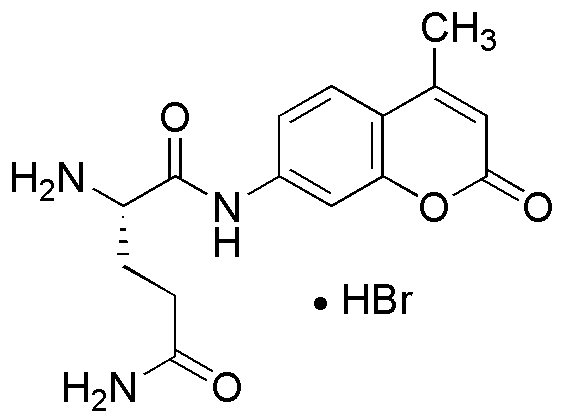L-Glutamine 7-amido-4-methylcoumarin hydrobromide is widely utilized in research focused on:
- Biochemical Assays: This compound serves as a fluorescent probe in various biochemical assays, allowing researchers to track enzymatic activities and cellular processes with high sensitivity.
- Drug Development: It plays a significant role in the pharmaceutical industry, particularly in the development of drugs targeting metabolic disorders, due to its ability to modulate glutamine metabolism.
- Cell Culture: In cell biology, it is used to enhance cell growth and viability in culture systems, making it essential for studies involving cancer research and regenerative medicine.
- Fluorescent Labeling: The compound is utilized for labeling biomolecules in imaging studies, providing clear visualization of cellular components and interactions in real-time.
- Research on Neurotransmission: It is valuable in neuroscience research, helping to investigate the role of glutamine in neurotransmission and its implications in neurodegenerative diseases.
General Information
Properties
Safety and Regulations
Applications
L-Glutamine 7-amido-4-methylcoumarin hydrobromide is widely utilized in research focused on:
- Biochemical Assays: This compound serves as a fluorescent probe in various biochemical assays, allowing researchers to track enzymatic activities and cellular processes with high sensitivity.
- Drug Development: It plays a significant role in the pharmaceutical industry, particularly in the development of drugs targeting metabolic disorders, due to its ability to modulate glutamine metabolism.
- Cell Culture: In cell biology, it is used to enhance cell growth and viability in culture systems, making it essential for studies involving cancer research and regenerative medicine.
- Fluorescent Labeling: The compound is utilized for labeling biomolecules in imaging studies, providing clear visualization of cellular components and interactions in real-time.
- Research on Neurotransmission: It is valuable in neuroscience research, helping to investigate the role of glutamine in neurotransmission and its implications in neurodegenerative diseases.
Documents
Safety Data Sheets (SDS)
The SDS provides comprehensive safety information on handling, storage, and disposal of the product.
Product Specification (PS)
The PS provides a comprehensive breakdown of the product’s properties, including chemical composition, physical state, purity, and storage requirements. It also details acceptable quality ranges and the product's intended applications.
Certificates of Analysis (COA)
Search for Certificates of Analysis (COA) by entering the products Lot Number. Lot and Batch Numbers can be found on a product’s label following the words ‘Lot’ or ‘Batch’.
Número de catálogo
Número de lote/lote
Certificates Of Origin (COO)
This COO confirms the country where the product was manufactured, and also details the materials and components used in it and whether it is derived from natural, synthetic, or other specific sources. This certificate may be required for customs, trade, and regulatory compliance.
Número de catálogo
Número de lote/lote
Safety Data Sheets (SDS)
The SDS provides comprehensive safety information on handling, storage, and disposal of the product.
DownloadProduct Specification (PS)
The PS provides a comprehensive breakdown of the product’s properties, including chemical composition, physical state, purity, and storage requirements. It also details acceptable quality ranges and the product's intended applications.
DownloadCertificates of Analysis (COA)
Search for Certificates of Analysis (COA) by entering the products Lot Number. Lot and Batch Numbers can be found on a product’s label following the words ‘Lot’ or ‘Batch’.
Número de catálogo
Número de lote/lote
Certificates Of Origin (COO)
This COO confirms the country where the product was manufactured, and also details the materials and components used in it and whether it is derived from natural, synthetic, or other specific sources. This certificate may be required for customs, trade, and regulatory compliance.


